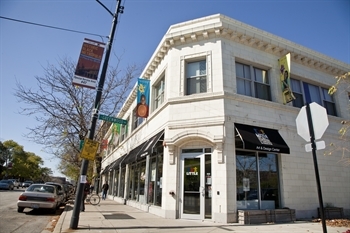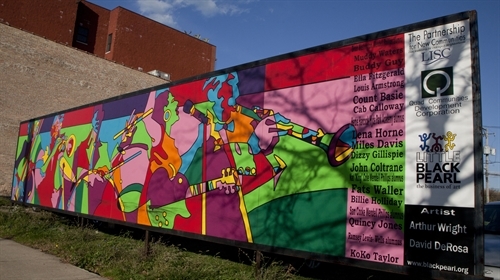
Emily Cikanek
When the Bronzeville Alliance, a coalition of local community organizations, invited the Metropolitan Planning Council (MPC) to help staff and provide recommendations to its Bronzeville Retail Initiative in 2010, MPC jumped at the opportunity to support coordinated retail planning, retention, and recruitment in this revitalizing South Side Chicago neighborhood. This project is a natural complement to Reconnecting Neighborhoods, a partnership since 2007 between the City of Chicago, Regional Transportation Authority, the consulting firm HNTB, and MPC’s Community Building Initiative, to advance retail, transit and pedestrian improvements in Chicago Housing Authority Plan for Transformation communities in Chicago’s Mid-South, Near West, and Near North sides.
The Challenge
Many African-American neighborhoods in Chicago have lost significant population for a variety of reasons: industry closures, housing foreclosures, public housing transformation, and opportunities for a better quality of life elsewhere are just a few. Concurrent with this reduction in density has been the rise of “superstores” such as Walmart and Target, which have dramatically shifted shopping patterns and reduced the role of smaller “mom and pop” stores in many neighborhoods. For all of these reasons, communities around the city are rethinking retail, including where and how they develop into promising retail corridors that can stabilize and cluster investment.
Recommendations
In August 2011, MPC convened a two-day task force of 11 experts in retail brokerage, market analysis, financing, and community level implementation. Charged with guiding the Bronzeville Alliance to best execute its goal of vibrant and concentrated retail corridors, the Bronzeville task force analyzed past plans and market data, toured the community, and interviewed more than 75 residents and stakeholders.
In the new report, Developing Vibrant Retail in Bronzeville, the task force recommends strategies for supporting coordinated retail planning, retention, and recruitment efforts in the community. Their chief conclusion was that, over time, the local market can support one primary retail corridor, and that corridor should be 47th Street due to its:
-

Emily Cikanek
- Good access, both by car (from the Dan Ryan Expressway to the west andLake Shore Driveto the east) and by public transit (CTA Green Line and buses).
In addition to the 47th Street Corridor, the task force encouraged ongoing support for clusters of retail at 51st Street and the Green Line, and 43rd Street and Cottage Grove/43rd Street and the Green Line.
In addition, the task force recommended an array of specific strategies to further the Bronzeville Alliance’s work:
- Form a cross-ward economic development arm to drive development and be a central hub of economic development information for the entire community across the 3rd and 4th wards and on all three corridors. This entity would strengthen local retail capacity and partnerships and build upon the work of existing organizations that work in specific parts of the community, such as the Quad Communities Development Corporation, 51st Street Business Association, and Renaissance Collaborative.
- Establish a new Special Service Area (SSA) along 47th Street in the 3rd Ward to continue the progress made by SSA 47, which stops at the ward boundary.
- Address both real and perceived safety challenges through targeted interventions to stop unwanted loitering and unsightliness by working with existing organizations such as the Concerned Citizens of Bronzeville, community-based block clubs, and local chambers of commerce.
- Finally, in order to support existing and new businesses and attract new spending to the community, the Bronzeville Alliance should work to cluster business development, enhance the opportunities for a mix of uses (retail, office, and residential), increase residential density, and create and attract new draws to the area, such as open spaces, plazas, and entertainment on vacant land throughout the Bronzeville community.
The full report on the task force’s findings will be available at the first public meeting of the Chicago Metropolitan Agency for Planning (CMAP)’s Bronzeville Retail Land Use Plan, on April 21, 2012. As part of its Local Technical Assistance program, CMAP will work throughout 2012 with the BRI team and a steering committee representing business owners, residents, elected officials and other stakeholders to finalize a land use plan for the three corridors. CMAP, MPC and BRI have been coordinating with the City throughout this process with the goal of using the eventual land use plan as a model for other Chicago neighborhoods also characterized by significant population loss and commercial over-zoning.
We look forward to a productive year ahead as BRI recharts its commercial course by deliberately creating dense, walkable, clustered, and vibrant retail corridors.

Emily Cikanek